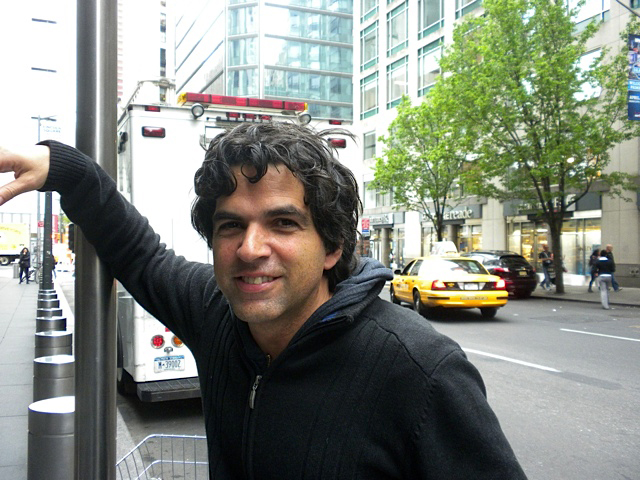
Cartoonist garners American praise

Swiss cartoonist Patrick Chappatte is the first non-American to be awarded the Thomas Nast Prize since its creation over 40 years ago by the Overseas Press Club of America. swissinfo.ch caught up with him in New York.
The award in one of 27 categories is recognition for his work for the International Herald Tribune (IHT), for which he has been a regular contributor for the past 11 years.
Chappatte says the prize, considered the most prestigious after the Pulitzers, also highlights the American roots of the IHT and cements its place among the US media.
Besides the IHT, the cartoonist also contributes to two Swiss dailies, Geneva’s Le Temps and Zurich’s Neue Zürcher Zeitung (NZZ).
swissinfo.ch: How important is it for you to work for a paper like the IHT which has a global audience?
Patrick Chappatte: It’s been a privilege to work for the IHT for the past 11 years and to be given this chance to comment, to look at the world and to translate the big and small issues into cartoons, as well as to convey my view of the world in a media that is global, but still American. And they let me comment on US politics as well, not just world affairs.
swissinfo.ch: Would you say political cartoons are food for thought?
P.C.: If they provoke a smile, it’s a first success. And if they can start a thought process, that’s another good step. But cartoons don’t make people change their mind. They don’t have that kind of transformative power. That’s not what they are meant for. You can use them as a communication tool, not a tool of transformation.
swissinfo.ch: How did a French-speaker end up working for English language publications?
P.C.: Switzerland is a small place – you reach its limits very fast. So I was at the top in my part of the world and couldn’t really do much more. This is kind of boring when you’re 25 or so and you think, well, what’s next?
I was very interested in English-speaking media, which I still consider to set a standard of excellence in journalism, and my wife and I decided to travel through South America and then move to New York. I quit the Tribune de Genève and just kept doing a weekly cartoon for L’Hebdo magazine.
I thought maybe I would try to find my way into the US press, become a cartoonist for the New York Times. I had that kind of American dream.
swissinfo.ch: What happened then?
P.C.: In 1995, we came to New York and I actually did start to work for the Times, but only as an illustrator, not as a cartoonist. When you’re an illustrator, you just put your art at the service of the story. It shouldn’t be too personal, only in the style, not in the content. So I did this for three years and it was a good opportunity to learn how to work for Americans.
We went back to Geneva in 1998. There I started working for L’Hebdo again, than later for Le Temps – I had already started working for “Die Weltwoche” in 1997.
swissinfo.ch: And how did you end up with the International Herald Tribune?
P.C: The IHT had been reprinting some of my cartoons once or twice a month, through a syndication agency subscription.
So I wanted to work for them. I had to convince them to pay me, when they were already getting the cartoons at a low price. It was a bold move on my side, but I could do it, because I had that American experience and the nerve to do this. I convinced the opinion editor of the IHT to meet me. I gave him my reasons why he should hire me. And in the end he said they were good reasons, that we should try it. And this is what I really love about America, that kind of pragmatic, open-minded spirit.
swissinfo.ch: Are there different sensibilities you have to take into account when working for different papers?
P.C.: There are differences between the various kinds of media, but it’s not so much so between Le Temps [French], the NZZ [German] or the IHT. They have a similar kind of readership. The difference is that two of them operate in Switzerland and the other has a global audience. But in the end, these audiences are not so different from each other.
There is more difference between Zurich’s “Blick” [tabloid] and the NZZ than between the NZZ, Le Temps and the IHT. So, I feel comfortable with those three publications, even if they are in different languages.
I’m not drawing for everybody. I think I’m drawing for an audience that already knows quite a lot, an audience that’s sort of sophisticated. I feel good working in that kind of environment.
swissinfo.ch: What is the biggest challenge coming up with cartoons that work in different languages?
P.C.: I need to find the kind of image that speaks to the readership of the publication. For the IHT I need to find a language that will speak to a global audience, which can require more of an effort. This doesn’t allow for much local references or word play, which you can use a lot in French for instance.
It could be easier to work for the IHT using just images. But my type of humour or comments very often need words, because I create a sort of comedy to pass on my comment, so I need the text too.
The challenge is to condense my message in the drawing in a way that can be understood by a global public – independently from a specific cultural background.
But it’s true, you never know exactly how a cartoon will speak to people the world over.
swissinfo.ch: Are there religious or moral boundaries that you have to respect for the IHT?
P.C.: Yes. You cannot draw naked or partly naked women, which you can do in Switzerland. It can happen there’s a breast to be seen, even in a neo-classical way. They don’t like that – and will tell me to cover that up!
swissinfo.ch: What drives your work?
P.C.: I do it for myself first. It’s an incredible chance – a chance to digest the atrocities, the horrors and idiocies of this world. I don’t know how other people do it, but I have the chance to do drawings about those issues and it’s my way to trying to make sense of it, translating it into something. And then you have that good feeling if on top of that you can make people smile or sometimes even laugh.
Patrick Chappatte was born in 1967 in Pakistan to a Lebanese mother and a Swiss father.
He spent his first five years in Singapore before his family moved back to Geneva where he attended school.
He got his first job as a cartoonist aged 20 with La Suisse, a Geneva newspaper that has since folded. He later worked for L’Hebdo magazine and the Tribune de Genève daily.
In 1995, he started working as an illustrator for the NewYork Times and for a short time as a cartoonist for Newsweek International.
By 1997, he began drawing for the German-language Weltwoche magazine, and in 1998 returned to Switzerland where he worked again for L’Hebdo before joining Geneva’s Le Temps newspaper.
Since 2001, his cartoons have appeared twice a week in the International Herald Tribune, and since 2002 in the NZZ am Sonntag.

In compliance with the JTI standards
More: SWI swissinfo.ch certified by the Journalism Trust Initiative





























You can find an overview of ongoing debates with our journalists here . Please join us!
If you want to start a conversation about a topic raised in this article or want to report factual errors, email us at english@swissinfo.ch.